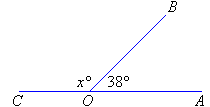
To get the missing angle were going to do 180 degrees minus the angle that we do know, which is 45 degrees. But we do know that a straight line adds up to 180 degrees. This problem gives us one angle that is 45 degrees and an ingle that we don’t know. Again, we know that supplementary angles definition is that when two angles add up to 180 degrees. The last question that were going to do on our supplementary angles worksheet is number 5. Now we know that this angle has to be 52 degrees. You do 180 degrees subtracted by 128 degrees to get the difference of 52 degrees. So we know that the missing angle has to be the difference between 180 degrees and 128 degrees.

We know that this angle here is 128 and we know that this line had to equal 180 degrees total.
#SUPPLEMENTARY ANGLE PLUS#
Again, the definition of supplementary angles is that when one angle plus a second angle adds up to 180 degrees. Jumping down to number two on our supplementary angles worksheet. Which means that this missing angle has to be 45 degrees because the two added together have to add up to 180 because they are supplementary. When you subtract 180 minus 135 you get 45 degrees as the difference. Also, the non-adjacent supplementary angles do not have the line segment or arm. Grab our worksheets on complementary and supplementary angles and master the skills in finding the unknown angles by subtracting from 90 or 180 degrees. So we are going to take 180 degrees and subtract it from the angle that we know which is 135 degrees. We know that both angles together have to add up to 180 degree. In the case of number one, we know the first angle is 135 and we know that both angles have to add up to 180 degrees because they form a straight line. We already know that a straight line is equal to 180 degrees. We already know that the supplementary angles definition is that when one angle plus a second angle add up to 180 degrees. In essence, the two angles together make a half circle. Thus, the supplementary angles are related to each other by 180 degrees. If you put two supplementary angle pieces together, you can draw a straight line across the top of the two angles.

In this case, one angle is said to be a supplement of the other. Let’s do a couple practice problems on our supplementary angles worksheet. Supplementary Angles When the sum of any two angles is equal to 180 degrees, then such pairs of angles are called supplementary angles. So if one supplementary angle is 50 degrees then the second supplementary angle has to be 130 degrees because the two added together have to add up to 180 degrees. This missing angle has to be 130 degrees because the two angles together have to add up to 180 degrees. We know that one angle is 50 degrees so we know that we can do 180 degrees minus 50 degrees to get the missing angle. We do know that supplementary angles are 180 degree. If you look, we already know that this angle here is 50 degree, but we don’t know how many degrees the second angle is.

You can see that there is a ray coming off of the straight like to create two angles. IN this example at the bottom, we have a straight line. The first thing we need to talk about is what are supplementary angles? The supplementary angles definition is when you have two angles that are added together to get 180 degrees. Step 1: Enter the angle in the input field Step 2: Now click the button Solve to get the result Step 3: Finally, the supplementary angle for the given angle will be displayed in the output field What is Meant by Supplementary Angle In Maths, two angles are said to be supplementary, when the angles add up to 180 degrees. These angles share these properties, making them unique angles and important ones to learn when working with applications and problems involving angles and algebra.This video is about answering the question what are supplementary angles. Congruent supplementary angles are angles that meet two conditions - they are congruent and they are supplementary.


 0 kommentar(er)
0 kommentar(er)
